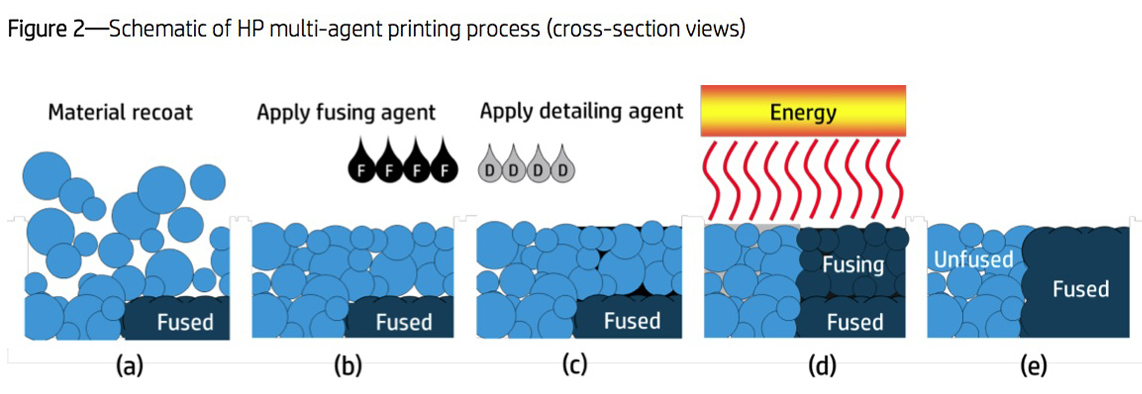Since Memjet filed its lawsuit against HP on August 11, 2015, a few dozen commentators have theorized that the suit will affect 3D printing. But it does not look like this case will be the start of the 3D Printing Patent Wars. Although the Memjet webpage alludes to the possibility that Memjet may go after HP based on its patented page-wide “waterfall” technology, it is unclear whether it intends to assert these or other patents against HP’s Multi Jet Fusion technology, or whether the asserted patents would even apply to MJF.
The truth is, it appears that this lawsuit has very little to do with 3D printing technologies. Memjet advertises that it has re-envisioned printhead design with its waterfall technology. This technology uses over 70,000 inkjets to print color pages very quickly. In its lawsuit, Memjet alleges that HP’s 2D OfficeJet Pro X Series, Enterprise X Series, PageWide XL Printers, and “printers using 4.25-inch thermal inkjet printheads, including HP Web Presses and Photo Kiosks,” infringe Memjet’s patents. Memjet generally asserts that these printers use HP’s “PageWide Technology,” which allegedly infringes Memjet’s waterfall technology. Memjet did not accuse HP’s MJF printer of infringement in this lawsuit, even though it could have.
So, why do people think this lawsuit involves 3D printing? When HP unveiled the MJF printer, it indicated that its PageWide Technology would assist the MJF printer with printing 3D objects much faster than current 3D printing technology. In addition, HP public documents describing PageWide Technology allude to the technology’s implementation in 3D manufacturing.
Today, printing solutions based on HP PageWide Technology offer businesses the opportunity to take their printing expectations to higher levels and move beyond the trade-off of quality and speed imposed by traditional inkjet printing solutions. Tomorrow, HP Scalable Printing Technology will advance printing off the page into the realm of 3D manufacturing enabling the production of components with properties and features practically unavailable—and even unimaginable—with current machining methods.
This may be why Memjet’s website suggests that HP’s 3D printers may also infringe.
Memjet may not have accused MJF of infringing because public information about MJF is limited. Another reason could be that Memjet’s patents are generally directed to printheads for 2D printing. Memjet asserts 8 patents in total, 7 utility patents and 1 design patent, but none of the patents includes the terms “3D printing” or “additive manufacturing”. The utility patents are generally directed to printheads that use micro-electromechanical systems (“MEMS”). MEMS technology stemmed from the basic techniques used to create semiconductors, for example, the way materials used to create semiconductors are deposited. By using MEMS technology, Memjet and other companies developed printheads that contain a very large number of print nozzles. Most of the patents in this lawsuit are directed toward an “ink distribution structure,” overlapping printhead segments, “a printhead assembly for a pagewidth printhead,” “a pagewidth inkjet printhead having [multiple] nozzles for delivering ink onto print media fed past the printhead,” a “fluid transporter . . . defining [multiple] channels that can each transport a respective type of fluid,” etc.
While some of these technologies may apply to 3D printing, many may not. For example, patents directed toward a pagewidth printhead may require an actual A4 paper page. Similarly, delivering ink onto print media fed past a printhead may not apply to 3D printers where the “ink” is also the “print media.” Further, any patent that claims to apply fluid to a substrate may not apply to 3D printing for the same reasons, since, generally, a fluid is not applied to color a substrate in 3D printing. Perhaps, when HP alludes to using PageWide technology in the 3D realm, it is actually referring to using MEMS technology that allows MJF to contain a very large number of print nozzles. According to HP’s MJF white paper, one x-moving carriage of the machine seems to jet materials to form a bed, after which, a second, y-moving carriage with an array of thousands of tiny nozzles jets “chemical agents” onto the layer, at a rate of 30 million drops per second.
While Memjet’s waterfall technology patents may potentially apply to 3D printing, the patents do not appear to have been written with 3D printing in mind. HP may have said it is using its PageWide printing technology in its 3D printers. And Memjet may have patents that cover various aspects of pagewidth printing technology. But the patents Memjet has asserted in the lawsuit may not apply to the HP’s Multi Jet Fusion printer. Also, since most 3D printers do not use pagewidth technology (if any at all do), it is unlikely that Memjet will sue other 3D printing companies for patent infringement. Thus, the Memjet v. HP case will probably be a footnote in the history of the 3D Printing Patent Wars, but stay tuned.




